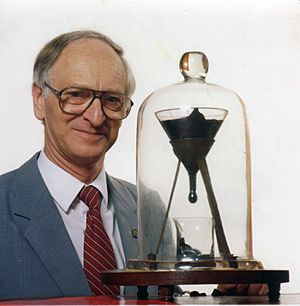Asphalt facts for kids

Asphalt, also known as bitumen, is a very sticky, black, and thick liquid or semi-solid material. It's mostly made from petroleum, which is what we get gasoline and other fuels from. You can find asphalt in most crude petroleum (oil) and sometimes in natural deposits on its own. It's the material that formed the famous La Brea Tar Pits.
The main way we use asphalt is in building roads. When it's mixed with other materials like sand, gravel, or crushed stone (these are called "aggregates"), it makes a strong and smooth surface for roads. Asphalt has many other names too, like pitch, tarmac, blacktop, asphalt concrete, or asphalt pavement. They all mean pretty much the same thing.
Sometimes, liquid asphalt is called tar. But be careful, because "tar" can also mean a sticky substance that comes from plants. When asphalt is solid, it's often called pitch. Even though a block of asphalt or pitch looks solid, it actually flows, but incredibly slowly! Scientists have done "pitch experiments" to show this. They watch how long it takes for a single drop to form and fall from a block of what seems like solid pitch.
What is Asphalt Used For Today?
Most of the asphalt we use today is for building things. It's mainly used as a key part of materials for paving roads and for roofing. Asphalt is made specifically for different jobs. This is done by refining it or mixing it with other things.
It's thought that about 102 million tons of asphalt are used around the world every year. A huge amount, about 85% of all asphalt produced, is used as the "glue" or binder in asphalt concrete for roads. It's also used for other paved areas like airport runways, car parks, and footpaths.
To make asphalt concrete, fine and coarse materials like sand, gravel, and crushed rock are mixed with asphalt. The asphalt acts like a strong glue, holding everything together. Sometimes, other materials like recycled rubber from tyres are added to the asphalt. This changes its properties to make it even better for specific uses.
About 10% of the world's asphalt production is used for roofing. Its ability to keep water out is super valuable for roofs. The last 5% of asphalt is used for sealing and insulating many different building materials. This includes coatings for pipes, backing for carpet tiles, and even some paints.
Asphalt is used in building and maintaining many different structures and parts, such as:
- Highways
- Airport runways
- Footpaths and walking paths
- Car parks
- Racetracks
- Tennis courts
- Roofing
- Damp proofing (keeping moisture out)
- Dams
- Linings for reservoirs and pools
- Soundproofing
- Coatings for pipes
- Coatings for cables
- Paints
- Waterproofing for buildings
- Waterproofing under tiles
- Making newspaper ink
- And many other uses!
Other Cool Uses
Roofing shingles use a lot of asphalt. Other uses include sprays for cattle, treatments for fence posts, and making fabrics waterproof. Asphalt is also used to make a special black paint called Japan black. This paint is known for being used on iron and steel. It's also added to some paints and marker inks to make them last longer in bad weather and to make the color darker. Plus, asphalt is used to seal some types of batteries during manufacturing.
See Also
Images for kids
-
Natural bitumen from the Dead Sea
-
A natural asphalt outcrop at Puy de la Poix, Clermont-Ferrand, France.










